Meditation App Development: Using examples like Headspace or Calm
Published: December 29, 2023
18 min read
In this article, you'll learn:
1
🔎 Understanding the Meditation App Market Size
2
📰 Success Story Behind the Headspace Meditation App
3
⚙️ Top Features of Meditation Apps like Headspace
4
💰 How Much Does it Cost to Build a Meditation App?
5
💵 How to Make Money with a Meditation App?
6
❓How to Create a Meditation App After All: Basic Steps
7
🛠️ Tech Tips
8
📚Case Study
9
💡 Takeaways
Some say that our smartphones make us unproductive and distracted. But what if we say that it depends on how you use them? Sometimes it may have the opposite effect!
Take a look at any meditation app. Nowadays some of them — for example, Headspace or Calm — have over 10.000.000 downloads. They are the bright example of how your smartphone can help you stay concentrated, rested and productive throughout the day.
Therefore, in this article, we will delve into the details of how to create a meditation app using the examples of popular apps like Headspace and Calm. We will discuss the top features for developing such an application, outline the development stages you can expect, share the technical stack that can expedite and facilitate the development process, and answer the main question: how much does it cost to develop a meditation app? So, shall we begin?
🔎 Understanding the Meditation App Market Size
To begin with, let's examine the state of the meditation app market. This will help us understand how lucrative this sector can be and the popularity of such applications.
In the years 2019-2020 (during the global quarantine due to the coronavirus), millions of people had to stay at home and seek new ways to suddenly fill these free hours and days. During this time, mobile apps proved to be the perfect solution in many industries — from food and grocery delivery to meditation, home fitness, online coaching, and others.
One of the biggest advantages of mobile apps is that anyone, anywhere, can use them. While most traditional offline businesses faced new challenges, companies focused on mobile devices found a new opportunity for growth and scalability.
Today, apps focused on mental health, particularly those aimed at corporate wellness app development, continue to maintain their popularity, as confirmed by recent studies from Statista:
- The Meditation Apps industry value will amount to US$4.43 bn by 2023. The market is projected to increase at a CAGR rate of 9.83% from 2023 to 2028 and reach $7.08 billion in 2028.
- In 2023, user penetration stands at 2.85%.
- This market is anticipated to have an Average Revenue Per User of US$46.31.
- US is set to lead with revenues amounting to US$940.30m in 2023.
The growth indicators in the meditation app market are indeed impressive. In addition to this, the popularity of such applications positively influences the practice mindfulness and well-being worldwide.
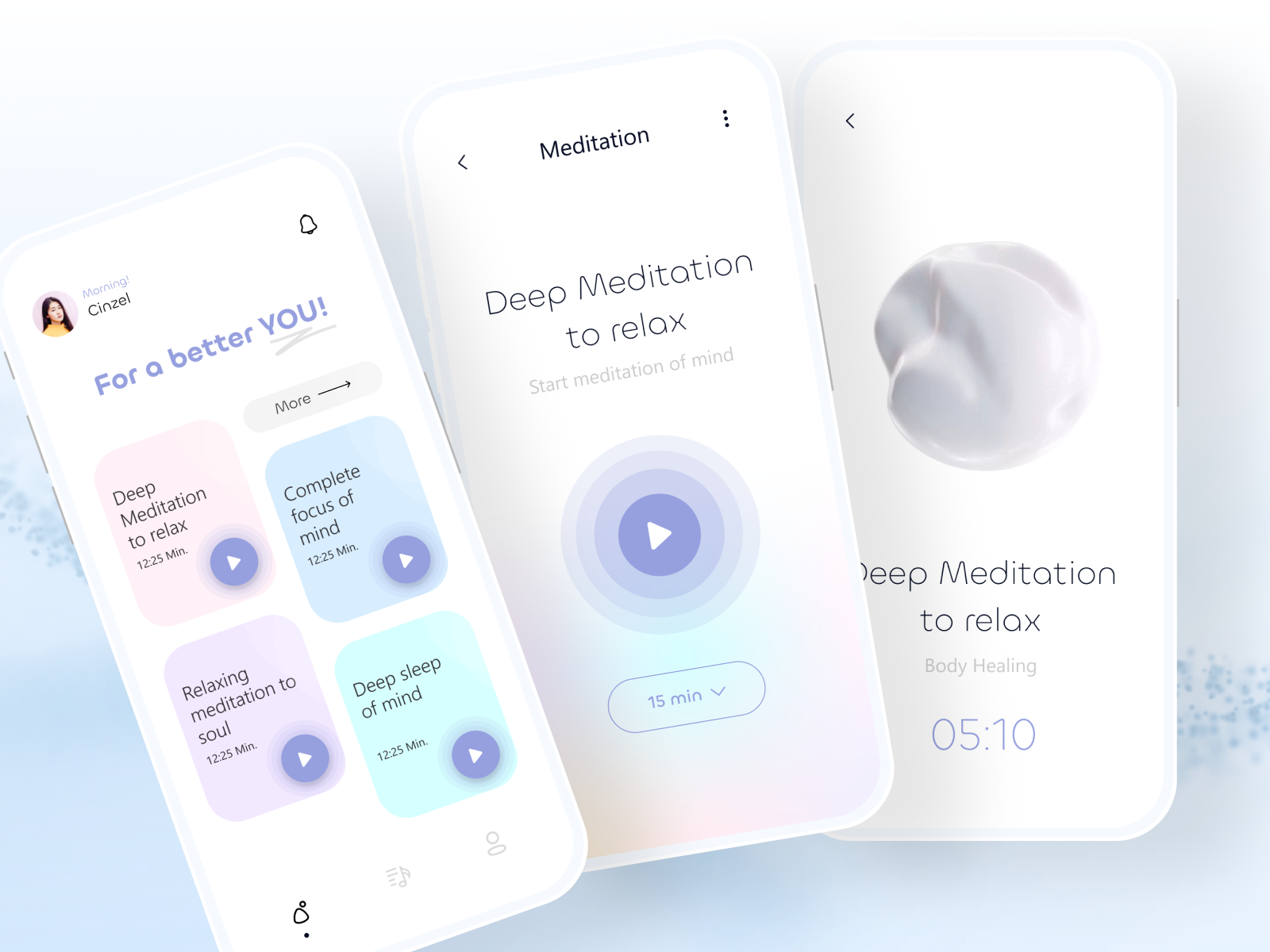
The app helps in forming healthy habits like regular meditation and mindfulness practice
(image by lazy kar)
We believe it would be beneficial to explore specific success stories in this market. Let's focus on a prominent example: the success of the Headspace app.
📰 Success Story Behind the Headspace Meditation App
Headspace was launched in 2010, and its origin story is quite interesting. The app was created by a few friends and one of them was… a Buddhist monk! Well, not as you may have imagined that, right?
Andy Puddicombe was born in Bristol but at the age of 22 left the country for a 10 years long Tibetan monastic training across Asia. After coming back to Britain, together with his friends he started holding live meditation events. The crew eventually came to the idea of meditation mobile app development.
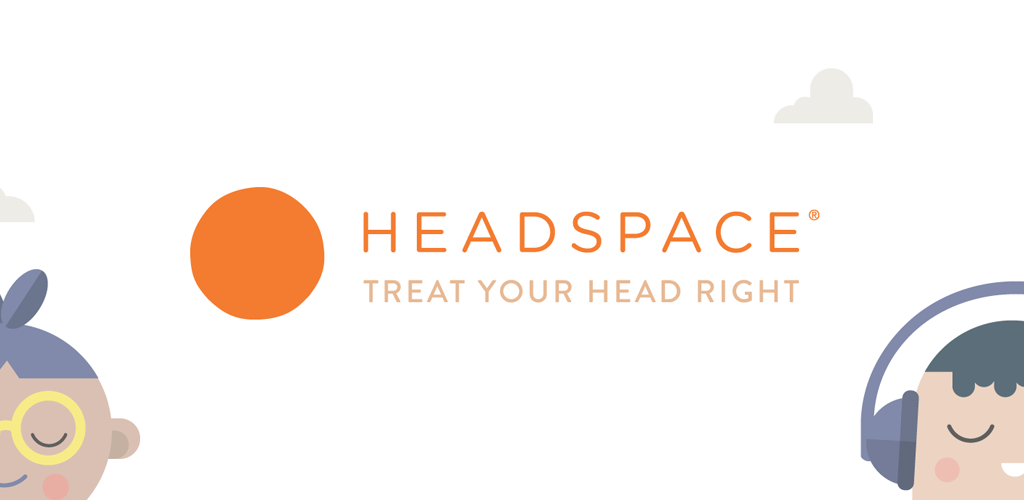
“Treat your head right” - Headspace app slogan
It likely wasn’t the most obvious decision for a guy who spent a decade device-free and was pretty skeptical about modern technologies. However, the app was their ticket to reaching millions. Moreover, it was something fresh and unique back then.
They didn’t have that much in the very beginning — around $50,000 from their friends and family. Taking into account that they couldn't be 100% sure that their idea will be profitable or at least won't go into the red, it's not a big amount of money.
The first version of the Headspace app was quite different from what we can download now. Actually, it was a set of 365 meditation sessions — all are recorded and voiced by Andy Puddicombe.
Lesson # 1: It’s possible to create a successful app without enormous spendings.
The company scaled gradually. In 2014 (4 years after the launch), they started to add tailored “packs” on specific topics like stress, sleep, sports, relationships, focus, and others.
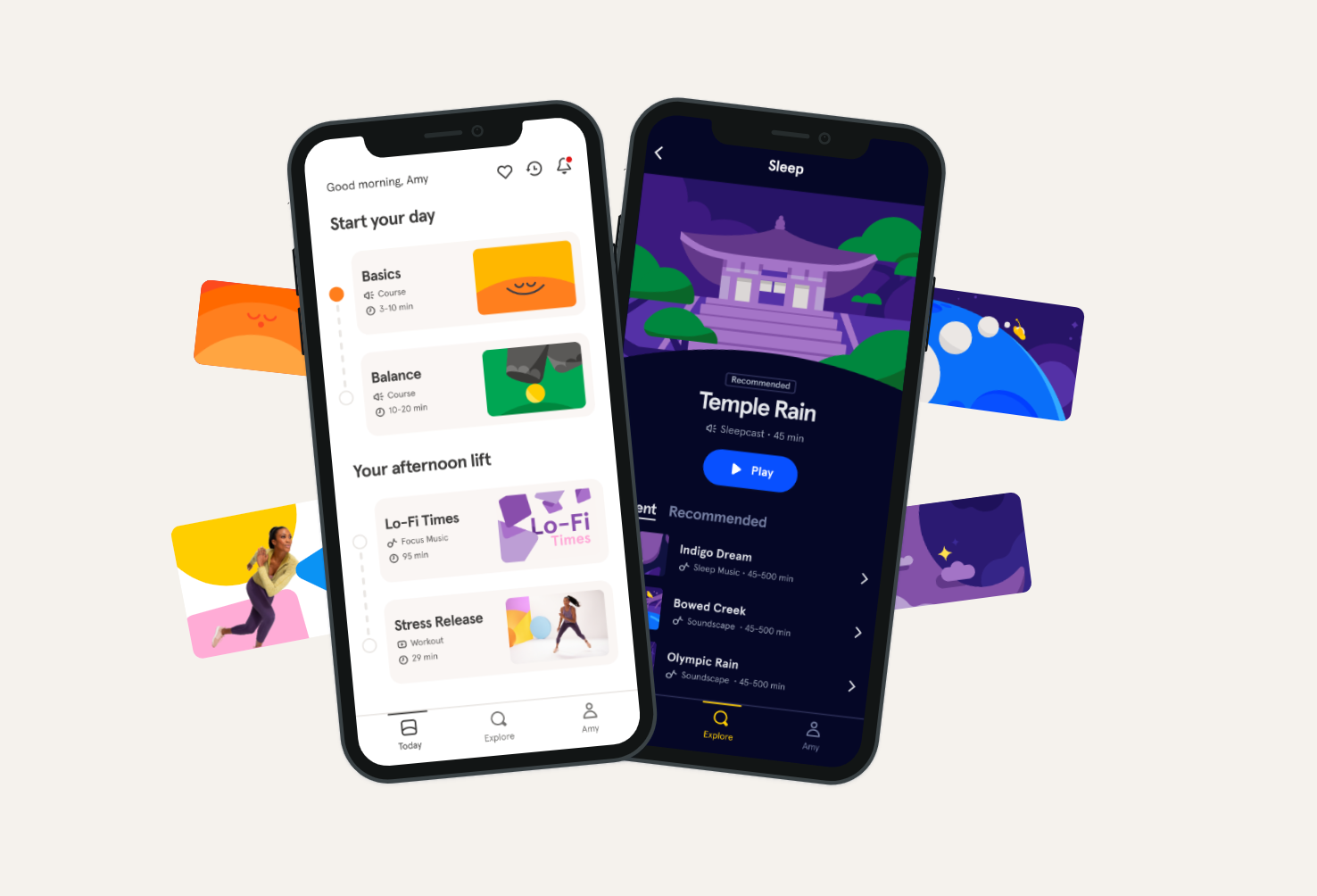
The Headspace app
Also, they’ve modified sessions for different levels of complexity: starting from sets for kids to tracks for experienced meditators.
Lesson # 2: start a meditation app with an MVP (minimum viable product, when implementing only essential features first) and then scale gradually.
Eventually, they managed to develop a meditation app with a wide user base that included both males and females ages 18 to 70 in over 200 countries. Impressive, isn’t it?
Today the Headspace app has over 70 million downloads and 3.3 million paying subscribers. The annual revenue is approximately $235 million in 2022. It proves that mindfulness app development can be a great choice from the business perspective as well.
But what are the secret components when you creating your own meditation app that helped the app (and other apps like Headspace) succeed? Here they are!
⚙️ Top Features of Meditation Apps like Headspace
When building a meditation app, it's crucial to consider top features. Let's look at them in more detail.
Onboarding Block: introduce meditation to users 🎎
Meditation becomes more popular with every coming year. Yet, for many people, it’s still something likely unknown and even a bit exotic. If you don’t want to leave your users frustrated, you should create a comprehensible onboarding screen.
An Onboarding Tutorial is a short walkthrough that appears when users open your app for meditation at the first time.
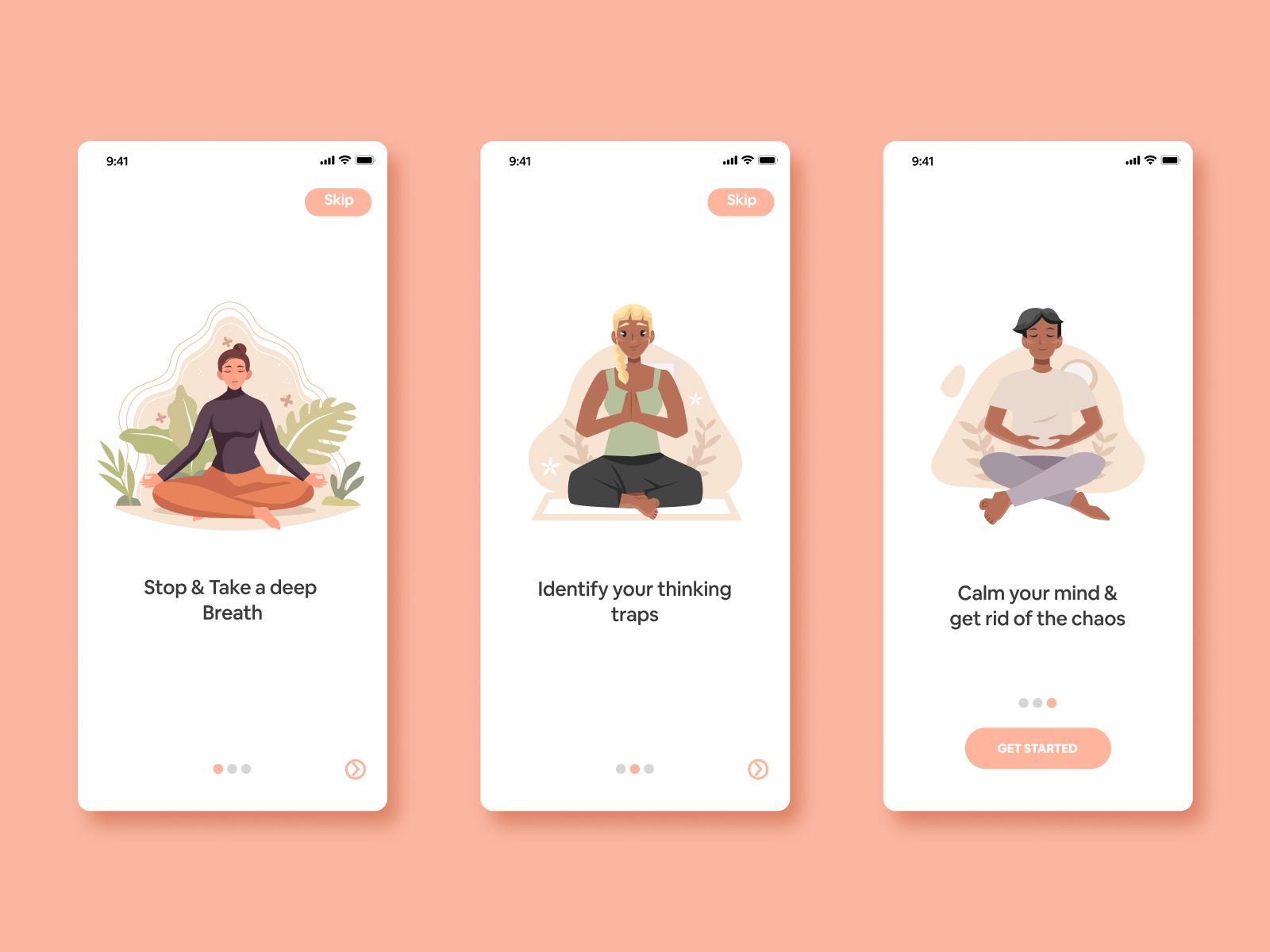
The example of onboarding screens
(image by Urvashi Dutta)
Here are a few tips to follow:
- Try not to reveal all the features at once. Onboarding should highlight only the most important features and help users to discover the app’s main possibilities. Additional features may be explained later, as soon as users reach them.
- Headspace uses a one-minute-long animated video to introduce the app to its users. This may be a good solution for you, too!
Specific Design: calm and smooth 🎨
Meditation practices are all about making you calm and concentrated. So, the design of your app should contribute to this goal as well.
Firstly, don’t use colors that are too bright. Some of the best choices can be:
- Blue.
- Green.
- Yellow.
- Brown.
- Purple.
- Pink.
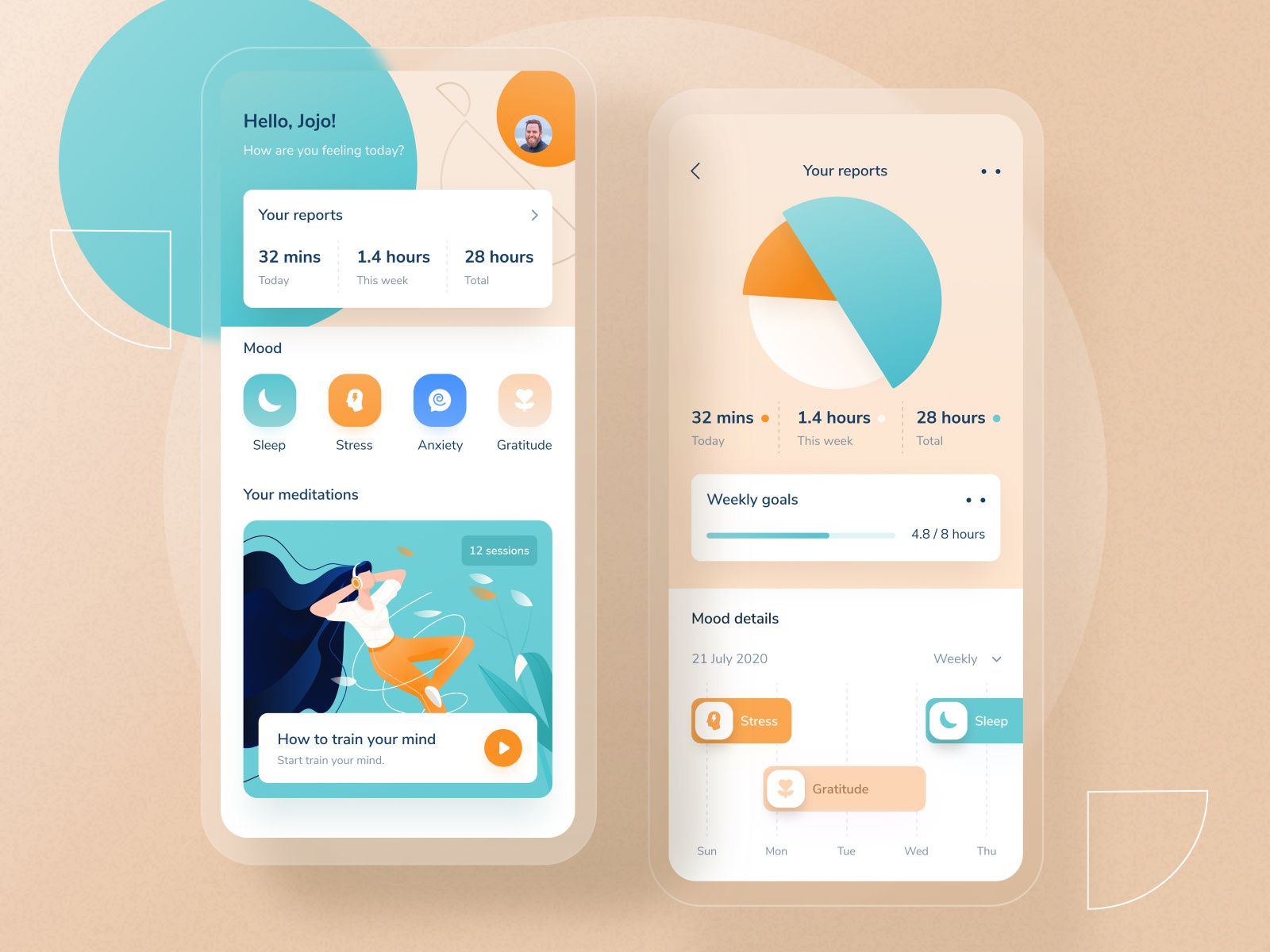
This mindfulness meditation app uses a nice pastel color combination in its design.
(image by Riko Sapto Dimo)
These are the colors that mainly used in Headspace and Calm apps, so if you want to create a mindfulness app like Calm, stick to this palette.
Secondly, make sure your design doesn’t look too cluttered. Actually, this is the golden rule for any kind of mobile application, not just for apps like Headspace.
If you take a look at the most popular relaxation meditation apps, you will see that they usually have a very minimalistic design - just the list with their available sessions and no excessive navigation elements. Thus, the application is more content-centered and not that distracting.
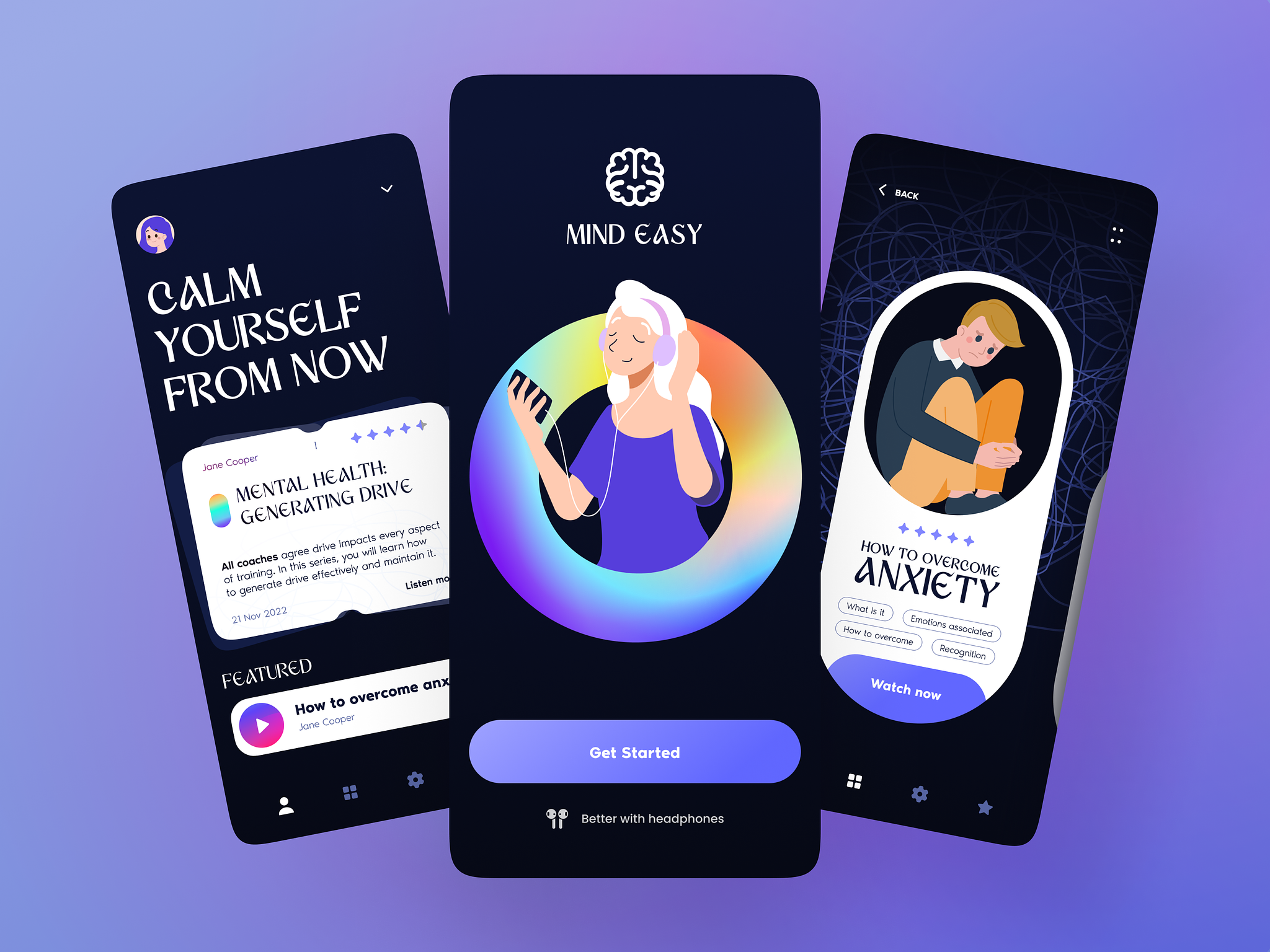
The app is designed to provide a seamless meditation experience, from beginner to advanced levels.
(image by Dmitry Lauretsky)
Thirdly, take care of animations. They should be smooth and quite plain. Your aim here is not to impress users with some complicated design features but to create a specific mood, a sense of relaxation that will help to catch the right vibe and get the best after-effect from your meditation sessions.
< LUNSegmentedControl developed by our Stormotion team is a great example of such a smooth animation. It can be used in apps like Calm to move between different tabs of screens.
Profiles: all about personalization 👤
Personalization is an essential part of any mobile application but if you want to create a meditation app like Headspace it’s particularly important for your project.
Here are 2 main reasons why you should care:
- Everyone has their motivation to meditate.
There are plenty of reasons why people start meditating in the first place. Some see it as a 10-minute break in the middle of a working day that helps to rest and clear the mind. For others, meditation may be key to a better sleeping schedule or a more efficient way of fighting stress, fear and depression.
Profiles provide users with a tailored experience according to their preferences. By using machine learning algorithms your mindfulness meditation app can analyze what session a user has already listened to and offer them similar sets to improve their experience. Sounds complicated, right? In reality — it isn’t. Check out the link to find out more.
- Gamification makes users more involved.
Yet, profiles can bring you more benefit from the business perspective as well.
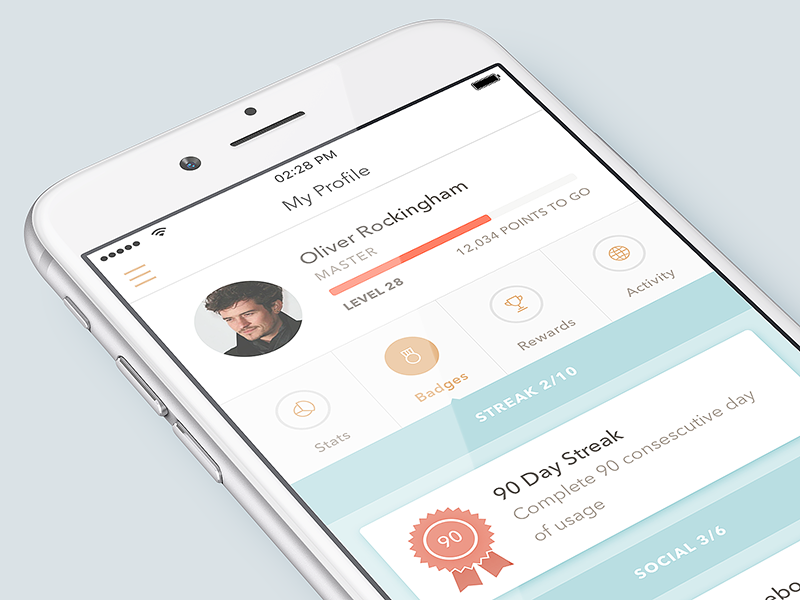
Profiles can be used to make users more involved in your app (image by Imran Ashraf)
For example, the Headspace app has its own achievement system — users can get badges for completing sessions 1, 3, 10, 15, 30, 90, 180 and 365 days in a row. The desire to keep up with the score makes them visit the Headspace app on a daily basis, thus, increasing retention and KPIs as well as eventually, getting more involved and purchasing a paid subscription.
Many people find themselves looking forward to progressing in the application and reaching new milestones, so feel free to use it to your advantage during your meditation app development services!
Meditation Session Sets: the heart of your app 🎧
The app feature we are going to talk about now is definitely the most important one if you want to develop a mindfulness app. So, what should you know about it?
Meditation sessions are made in the form of podcasts. These are conversations on selected topics, combined with background calming music or nature sound effects. The duration of such sessions isn’t limited, but the generally accepted format is a recording of 3, 5, 10, 15, 20 or 30 minutes long. However, longer options (45 or 60 minutes) are also possible.

Collaborations with mindfulness experts ensure that the content is authentic and beneficial.
(image by Yev Ledenov)
As we’ve already said, everyone has their personal reasons for meditating. One of the pillars of Headspace’s success, as we learned it earlier, is that they’ve managed to offer valuable content to people of different sex, age and needs. We'd recommend taking that into account when you create your own meditation app.
At the app MVP stage, it’s possible to create a single pack (or a few ones) to introduce users to meditation techniques and cover a few basic topics like stress, concentration and sleep patterns.
Yet, as your user base will grow and scale, adding new session sets or improving the previous ones will become one of the most important tasks for you.
Play Screen: let your users relax ▶️
This screen is one of the most important in mindfulness apps. It also has a pretty plain and minimalistic design. The central part is usually occupied by a “play” button with smooth animation, to create a specific mood for their session.
Also, don’t forget to place a nice background image. The best options to go are some beautiful landscapes with soft green and blue colors or gradients with warm colors.
Finally, you may also add some background music. Yet, it’s not obligatory. For example, the Headspace meditation app has only Andy Puddicombe’s voice talking to you while the Calm app enhances sessions with nature sounds.
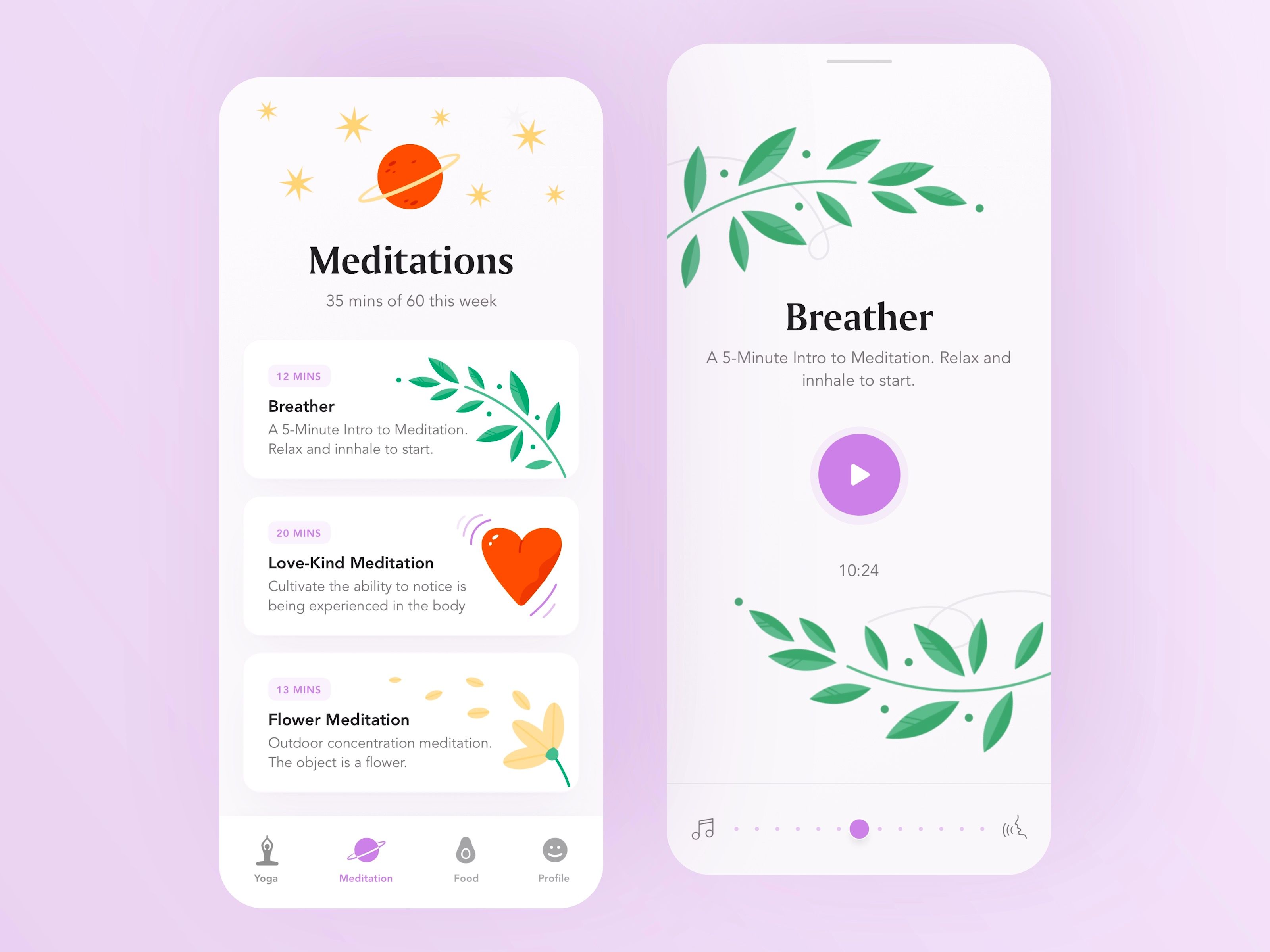
The app plays a significant role in mental health maintenance by providing easy access to meditation tools.
(image by Alex Pesenka)
Furthermore, we want to share with you a few ideas regarding additional functionality that you can implement:
- Download and cache sessions in order to listen to them later, when internet connection is missing.
- Listen to podcasts in the background, after leaving the app.
Discovery Screen: let users explore the app on their own 🕵️♀️
To keep users engaged with your app you need them to check it at least once a day. And nothing can motivate them to do it as much as the discovery option.
Basically, this is a separate screen where users can explore new meditation packs, sessions and other valuable content.
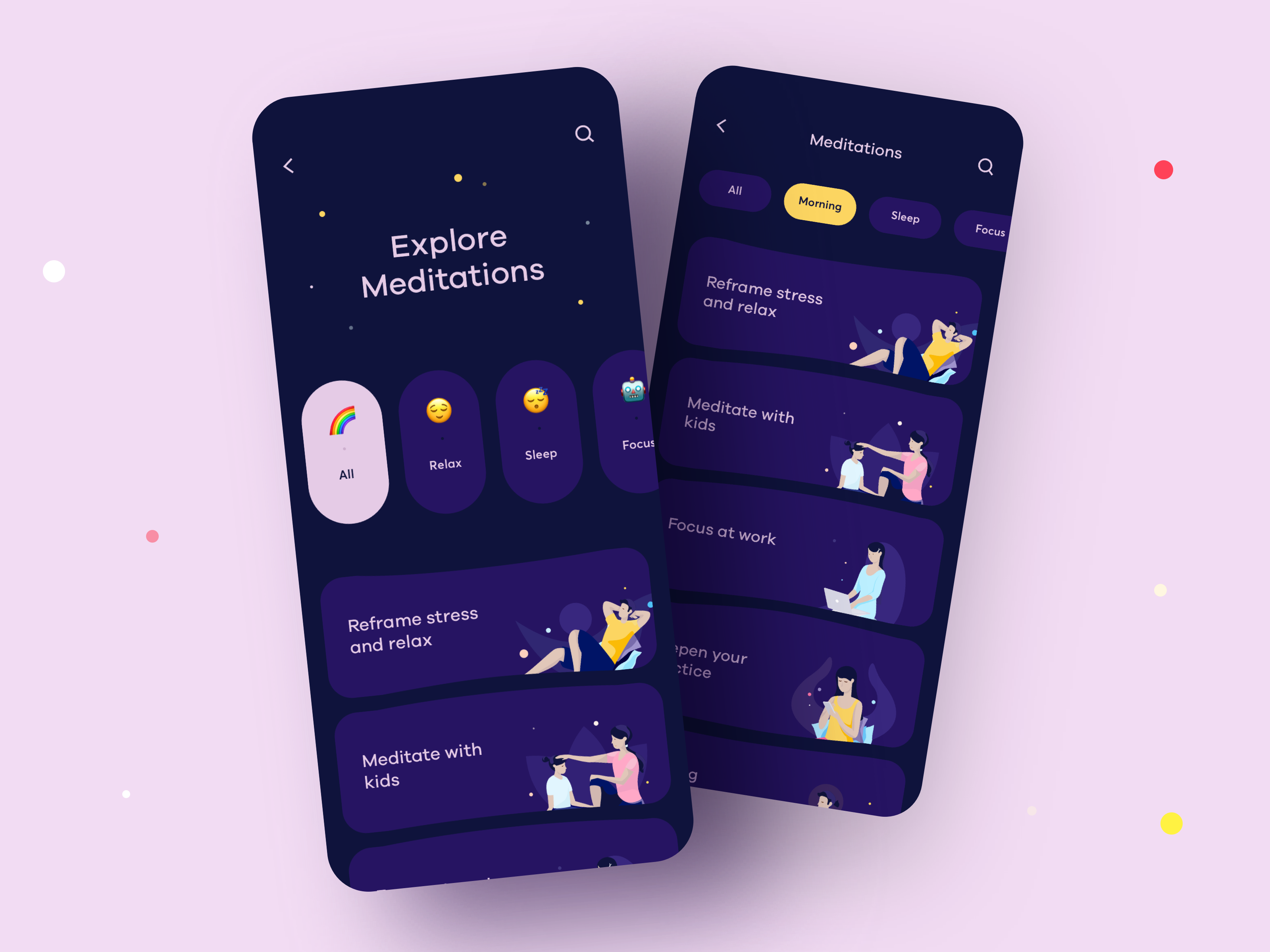
Your app should offer users different meditation packs and playlist
(image by Cuberto)
Providing a few free trial sessions (considering that packs usually have 10-30 sessions) can have a positive after-effect for your business. Users will be more likely to buy a pack or a subscription after they get a chance to experience locked sessions on their own for free.
Push Notifications: keep the audience engaged 🔔
Finally, don’t forget to integrate push notifications when you create a mindfulness app. It’s a powerful retargeting tool that will help you to keep the users near your app.
Here are a few ideas on how you can use smart notifications in apps like Headspace:
- Simply remind users to visit your app and have another meditation session according to their schedule (users usually listen to 1 podcast a day).
- Notify when new packs are available or the old ones are extended.
- Announce discounts, giveaways and other news that may encourage people to buy paid packs or subscribe.
- Don’t forget about the gamification element! Remind users to keep their score high and use the app every day.

Push notifications are great for retargeting (image by sarafrbrito)
So, these were the top app features that you will need to create a meditation app like Calm. Remember, to enhance user engagement, it's crucial to analyze user behavior and tailor the app's features accordingly. Earlier we also mentioned that the meditation app development doesn’t require as many financial resources as you might think. So, in the next section we'll talk about the cost to build a meditation app.
The key features of how to make a meditation app like Headspace include:
- Onboarding Block
- Specific Design
- Profiles for Personalization
- Meditation Session Sets
- Play Screen
- Discovery Screen
- Push Notifications
These features focus on user engagement, personalization, and a calming user experience, essential for a successful meditation app.
💰 How Much Does it Cost to Build a Meditation App?
As usual, our app development team prepared a rough estimation of the main features. Don’t forget that the estimation for your project might be different depending on your individual list of features and other factors.
Yet, the cost estimation of the Headspace app by the Stormotion team will help to form a general idea of the possible cost to build a meditation app:
Features & Development stage estimated in hours
Using React Native
Feature/Development stage | Minimum Hours | Maximum Hours |
|---|---|---|
Authentification 🔐 | ||
Splash screen | 10 | 18 |
Tutorial | 20 | 28 |
Sign in screen | 22 | 32 |
Sign up screen | 22 | 34 |
Password reset screen | 28 | 38 |
Facebook integration | 20 | 34 |
Spotify integration | 32 | 46 |
Session intro | 16 | 28 |
Home Tab 📱 | ||
Session screen | 38 | 56 |
Discover Screen | 14 | 32 |
Packs page | 18 | 30 |
Singles page | 16 | 28 |
Kids page | 20 | 34 |
Animations page | 20 | 32 |
Pack screen | 22 | 32 |
User Profiles 👥 | ||
Achievements system | 28 | 46 |
Invite a buddy | 24 | 34 |
Settings screen | 18 | 38 |
Reminders | 24 | 34 |
iOS Calendar integration | 34 | 46 |
Offline downloads | 38 | 52 |
Tutorials 👨🏫 | ||
Overlay tooltip | 18 | 28 |
"GOT IT" block | 14 | 22 |
Other 📋 | ||
Subscription Flow | 44 | 62 |
Fullscreen Video Integration | 26 | 44 |
Background Music Management | 32 | 50 |
UX Design | 28 | 44 |
UI Design | 44 | 62 |
Content Management System | 130 | 140 |
QA | 80 | 102 |
Total Hours | 900 | 1306 |
Approximate costs | $45.000 | $65.300 |
Note: we took an average rate of $50/hour but it depends on many different factors so don't think of it as the final price.
This block of our article was about spending money. But what about earning it? Read on, cause we have something to share with you on this topic too.
💵 How to Make Money with a Meditation App?
You could notice that we’ve already shared a few ideas on how to make money with this kind of app. Nevertheless, we decided to make up a table where we listed all the possible options. Enjoy!
- Pay Per Download
Paid downloads are quite outdated and, frankly speaking, not an effective way to make revenue with such an app. Modern users don’t want to buy a pig in dwell and prefer to explore the app before paying for it. Yet, there are still some apps that use this monetization model.
Example: Buddhify - $4.99 for iOS and $2.99 for Android.
- Subscription
Subscriptions is the most common monetization model for apps like Headspace. The idea behind it is as simple as that: users get unlimited access to all the features as long as they pay for them on a monthly or yearly basis. subscription plans are used by the main industry leaders, so their efficiency and profitability don’t need additional confirmation.
Examples👇
$12.99/month | $69.99/year | $9.99/month | $29.99/year |
- In-App Purchases
Another option for you is to implement in-app purchases. That will allow users to buy specific session packs without unlocking other content.
Example: the Insight Timer app offers (along with the monthly subscription) to buy separate collections at a price of $2-$3.
- Ads
Finally, you can generate revenue from advertisements and leave your app completely free. However, since you are going to make your own meditation app, you might want to think about users' mental state in the first place. Thus, we'd not recommend using this monetization model since some people might find it somewhat irritating.
❓How to Create a Meditation App After All: Basic Steps
When you're wondering how to create your own meditation app, our list of basic steps can help you along the way. Let's go through each point.
Market Research and Competitive Analysis
This is always the first and key stage in creating any application. You need to track and understand current market trends and the annual growth rate of meditation applications. This is what we talked about with you at the beginning of the article. In your work, use authoritative sources such as Statista and so on.
Then identify your competitors, look at their products, and analyze their advantages, strengths, and weaknesses. Here it is important to pay attention not only to the basic functionality of the application and its design but also to the methods of communication with customers and marketing strategy.
Also, define your target audience. What are their needs and preferences?
Defining Your Unique Selling Proposition (USP)
Determine the type of meditation application you want to develop. This could be guided meditation, a mindfulness app, or a community app. Think about the unique value of your application that will distinguish it from competitors. This could be the implementation of unique features or approaches, such as personalized user experience or e-commerce features.

One more feature: guided breathing techniques also help users to relax and focus.
(image by Sèrgi Mi)
Planning and Strategy
Outline your business idea, including the problems your application solves, target audience, market and competitor research, functionality, design ideas, and promotion strategy.
Also, plan your meditation app development process. You can hire a team of developers, and they will help you decide on the platform (iOS, Android, or cross-platform), operating system and the possibility of adding special features. Also, don't forget to plan your app's monetization strategy (e.g., subscriptions, in-app purchases, advertising).
Design and User Experience
We now proceed directly to the creation of the application. To start, you need to design the architecture of the application and develop the design. Since this is a meditation application, we advise not to use bright colors in the design. Also, in this matter, it is better to give preference to minimalism, do not overload the screens with unnecessary text, fancy and bold fonts, etc.
Development and Architecture
Choose the right technology stack. We at Stormotion prefer to work on React Native, as this platform allows the creation of applications simultaneously on iOS and Android, which significantly saves development time and money for our clients.
First of all, develop the main functions of the application, such as login/registration, search, progress tracking, in-app payments, and user profiles.
App Deployment and Marketing
After the meditation app development is completed, thoroughly test the application for functionality, usability, and performance. Deploy the application on the appropriate platforms (App Store, Google Play Store). Start implementing the marketing strategy.

Leveraging social media platforms for promotion can significantly increase the app's user engagement.
(image by Raffialdo Bayu)
Ongoing Maintenance and Updates
Regularly update the application with new features and content. Monitor user feedback and analytics to continually improve the application. Maintain transparency and interact with the user community for sustainable growth.
Determine the industry trends by performing market research and analyzing competitors when building a meditation app. Provide a unique selling proposition for the app, mainly personalized experiences. Develop a business strategy to identify your target audience, design, and monetization. Keep it simple when it comes to design, and choose the right technology stack for development. Build basic features, conduct thorough functional testing, and release the app on appropriate systems. Come up with a marketing plan and keep updating the app with regular feedback and analyses of users.
🛠️ Tech Tips
We would also like to share a few tech tools that will help you create a great mindfulness application. Check them out:
- For sending push notifications, Firebase SDK can be applied.
- Braintree and Stripe SDKs are good tools for integrating in-app payments for purchasing a subscription or separate meditation blocks.
- LUNSegmentedControl may be used as a nice UI element of your application.
- Facebook Mobile SDKs can be used for many different purposes: a fast sign up process, analytics, monetization, providing customer support through Messenger etc.
📚Case Study
We have acquired expertise in meditation mobile application development, a field that has witnessed high growth in demand. Some of our projects that we undertook include Feel Amazing and Mindance each having its own set of challenges and solutions.
There is a meditation and wellness application Feel Amazing that allows users to unwind their minds, and become a better version of themselves. It provides an array of functions for improving mental health by way of guided meditations, mindfulness workouts, and health monitoring.
Feel Amazing focused on simple, intuitive design. We followed the minimum approach, creating the application that didn’t overload with soothing colors and navigation. The hybrid development approach saved development time while enabling concurrent iOS and Android deployment.
Mindance is one of the most unique mental health mobile apps. It revolves around a theory of mental health, incorporating different courses or lectures in the form of text, video, or audio providing psychological information about a particular issue. It also includes events by Familienservice (application owner company), which users can sign up for, as well as group and 1: 1 visits with psychologists and psychotherapists.
Currently, Mindance is a B2B product. Familienservice deals with client companies who want their employees to have access to the app. Companies sign various contracts that provide different levels of access to the features by different departments depending on their contract type. The goal is to enhance a positive mental attitude within the company.
💡 Takeaways
Embarking on the journey of how to create a meditation app for startup development seems like a promising idea. It’s not very expensive or complicated from the development perspective, yet, it can be quite profitable.
The top elements of the app that require the most attention are:
- Clear and comprehensive Onboarding Block to introduce the main idea and features of the app.
- Specific motion UI with calm colors and smooth animations.
- User Profiles that allow to tailor the experience and engage the audience with gamification elements.
- Various sets of meditation sessions.
- Plain Play Screen with a minimalistic UI.
- Discover Screen where users can explore your app on their own.
- Push Notifications to keep people engaged.
Contact us! We are ready to help you make your own meditation app and provide an estimation of your project within 24 hours. Let’s change the world together!
Was it helpful?
Questions you may have
Take a look at how we solve challenges to meet project requirements
Do you have experience integrating IoT devices or wearables into meditation apps for a more immersive experience?
Yes, our team of meditation app developers have experience in creating meditation applications with IoT device integration. We worked on an application that integrates with saunas via Bluetooth, allowing people to listen to instructions and control the app while sitting in the sauna. This experience is closely related to one of our main directions - creating IoT applications. We specialize in developing interconnected systems that enhance user interaction through seamless integration of digital applications with the physical environment.
How do you handle meditation app design and user experience (UI/UX design) to create a calming and user-friendly environment?
Creating a calming and user-friendly environment is very important, especially in building a meditation app. In our work, we follow these principles:
- Minimalist Design
- Soothing Color Palette
- Intuitive Navigation
- Responsive and Adaptive Design
- Engaging yet Relaxing Content
- Personalization
Can you assist with content creation, such as guided meditation scripts, audio recordings, or video production?
Certainly! While our primary focus is on development, we have partners who can assist with content creation aspects such as illustrations, audio processing, and more.
What strategies do you employ for app monetization (e.g., subscription models, in-app purchases, ads), and can you provide insights into the most effective monetization approach for a meditation app?
For app monetization, particularly when aiming to build a meditation app, several strategies can be employed, each with its advantages and considerations. Here are some common approaches:
- Subscription Model
- In-App Purchases
- Freemium Model
- Ads
- Sponsorships and Partnerships
- One-Time Purchase
In terms of the most effective monetization approach for a meditation app, it largely depends on the target audience and the unique value proposition of the app. Subscription models are generally effective due to the ongoing nature of meditation practice and the opportunity for continuous content delivery. However, a combination of strategies (like freemium with in-app purchases) can also be effective in catering to a wider range of user preferences and willingness to pay.
It's important to balance monetization with user experience, ensuring that the revenue model aligns with the calming and soothing nature of the app. Regular market research and user feedback can provide insights into which monetization strategies are most effective for your specific app.
How do you approach user data privacy and security, considering the sensitive nature of meditation app users' data?
User data privacy and security are of paramount importance. We adhere strictly to data protection laws like GDPR and HIPAA, ensuring compliance through explicit user consent and transparent privacy policies. Our approach focuses on collecting only essential data, minimizing the risk associated with data storage and processing. We employ robust encryption methods for both storing and transmitting user data, ensuring it remains secure against unauthorized access.
What is your approach to app scalability and performance, especially if the user base grows rapidly?
Our approach to ensuring app scalability and performance in the face of rapid user base growth involves a combination of cloud-based infrastructure and microservices architecture. This setup allows us to efficiently manage resources and scale specific aspects of the app independently as needed. We place a strong emphasis on performance optimization through efficient data handling and caching strategies, which helps in reducing load times and enhancing user experience.
Can you assist with submitting the app to app stores (e.g., Apple App Store and Google Play Store) and navigating the approval process?
Yes, we can certainly assist with submitting your app to app stores like the Apple App Store and Google Play Store, and help navigate the approval process.
How do you handle ongoing app maintenance and updates, including bug fixes and feature enhancements?
After the product release, we understand that the development process involves constant improvement and correction work. This is where post-release maintenance becomes crucial.
The maintenance cycle is a continuous process that includes releasing product versions, collecting user feedback, formalizing new requirements to create a backlog, and then performing development iterations based on this feedback.
For urgent issues like third-party SDK problems, we immediately start working on solutions. Routine bugs and crashes are proactively fixed using analytics tools like Sentry or Firebase Crashlytics to detect issues.
In addition to technical maintenance, we also offer post-release consulting. This service includes free consultations to help companies plan out their post-release maintenance and future product ideas. We assist in creating technical roadmaps and provide budget estimations for future developments.
Our post-release maintenance and updates are designed to ensure that the app not only continues to function smoothly but also evolves in line with user expectations and technological advancements.
Can you provide references or client testimonials from previous app development projects?
Of course, you can see this in our portfolio!
What is your project timeline and development process, from concept to launch?
Our project development process from concept to launch includes several key stages. It starts with Project Initiation & Planning, where we define the project's goals and set up a detailed plan and team. This is followed by Project Executing, using Agile methodologies like Scrum for efficient development through sprints and regular meetings.
During the Project Controlling phase, we focus on task management, efficiency, and quality control. The process concludes with Project Closing, where we finalize the product and prepare it for release after thorough checks and client approval.
An essential part of our process is Project Discovery, involving collaboration with stakeholders to identify opportunities and reduce risks. We also prioritize regular technical debt management and rigorous Quality Assurance (QA) to ensure the software is flawless and meets customer needs.
Post-release, we provide ongoing support and consultations, helping with aspects like budgeting and strategic adjustments. This structured approach ensures timely, within-budget project completion, meeting the highest quality standards for successful market entry.
What is the estimated cost of developing a meditation app, and how do you handle changes in project scope that may arise during development?
When developing a meditation app, the cost can vary significantly based on the app's complexity and features. For a basic app, the cost might start from $45,000 but more sophisticated apps with extra features and custom designs can reach $65,000 or more.
To handle changes in project scope during development, we employ a flexible and transparent approach. We use Agile development practices, allowing for flexibility and adaptability to changes. This is complemented by regular communication with our clients to ensure any scope changes are promptly discussed and understood.
In the event of a proposed scope change, we conduct an impact analysis to assess how this change will affect the project in terms of timeline, resources, and budget. Based on this analysis, we provide revised estimates and seek formal client approval before proceeding.
Our contracts are designed to be flexible, accommodating scope changes with clear procedures for managing these changes, including adjustments to budget and timeline. We also work closely with clients to prioritize new features, ensuring effective project management of the development timeline and budget.
Overall, our approach ensures that scope changes are managed efficiently, keeping the project on track while maintaining the quality and integrity of the final product.
How do you stay updated on the latest trends and technologies in meditation mobile app development?
To stay updated on the latest trends and technologies in mindfulness app development process, we engage in continuous learning and research, regularly attending industry conferences and workshops. Analyzing user feedback and app performance data is crucial for us to understand user preferences and improve our offerings. Additionally, we prioritize the professional development of our team and experiment with new technologies and advanced features to ensure our apps are innovative and effective.
Read also

How to Create a Fitness App: Process, Costs, Estimates and Challenges

What is Prototyping in IoT and Some Practical Advice

What is IoT Device Management?
Our clients say
![Stormotion client Max Scheidlock, Product Manager from [object Object]](/static/33294af91c38256bcd5a780ddc41861a/b0e74/max.png)
They understand what it takes to be a great service provider, prioritizing our success over money. I think their approach to addressing ambiguity is their biggest strength. It definitely sets them apart from other remote developers.
Max Scheidlock, Product Manager
HUMANOO
